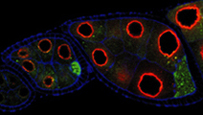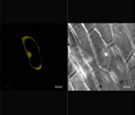Kusabira-Orange
- Bright orange fluorescence
- High pH stability
- Monomer/dimer
CoralHue™ Kusabira-Orange (KO1), from the stony coral Fungia concinna (Kusabira-ishi in Japanese), absorbs light maximally at 548 nm and emits orange light at 561 nm. KO1 rapidly matures to form a fluorescent dimeric complex. KO1 can be used to mark cells or to report gene expression without problems stemming from protein aggregation.
CoralHue™ monomeric Kusabira Orange (mKO1) maintains the brilliance and pH stability of the parent protein. mKO1 can be used to label proteins or subcellular structures or for FRET analysis.
CoralHue™ mKO2 is a mutant of mKO1 that features rapid maturation. mKO2 can be used to label proteins or subcellular structures or for reporter assays.


KO1

mKO1

mKO2

| Kusabira-Orange1 spectrum data files (text files) | |
|---|---|
| Kusabira-Orange1 excitation ( |
Kusabira-Orange1 emission ( |
| mKusabira-Orange1 excitation ( |
mKusabira-Orange1 emission ( |
| mKusabira-Orange2 excitation ( |
mKusabira-Orange2 emission ( |
Note: The file is in a tab-delimited text format. It contains values of the wavelength (0.5nm spacing) and brightness (fluorescence intensity peak value normalized to 1). Use a spreadsheet program to create a spectrum that will help you in choosing the appropriate excitation filter, dichroic mirror and fluorescence filter.
| CHARACTERISTIC | KO1 | mKO1 | mKO2 |
|---|---|---|---|
| Oligomerization | Dimer | Monomer | Monomer |
| Number of amino acid | 218 | 218 | 218 |
| Excit./Emiss. maxima (nm) | 548/561 | 548/559 | 551/565 |
| Molar Extinction Coefficient (M-1cm-1) | 73,700 (548 nm) | 51,600 (548 nm) | 63,800 (551 nm) |
| Fluorescence quantum yield | 0.45 | 0.60 | 0.62 |
| Brightness*1 | 33.2 | 31.0 | 39.6 |
| pH sensitivity | pKa<5.0 | pKa<5.0 | pKa=5.5 |
| Cytotoxicity*2 | Not observed | Not observed | Not observed |
| Resistance to PFA fixation | Not tested | Not tested | +++ |
*1Brightness: Molar Extinction Coefficient ×Fluorescence Quantum Yield / 1000
*2Toxicity when expressed in HeLa cells
Kusabira-Orange are useful for labeling organelle.

Kusabira-Orange is easily expressed and detected in a wide range of organisms. It has been demonstrated in nucleoplasm, plasma membrane, endoplasmic reticulum and mitochondrial targeting signal models.
Kusabira-Orange is a useful protein for expression into various species.
 |
 |
 |
 |
KO1 TG pig Provided by Dr. Nagashima |
mKO1 fused with Vasa protein expressed in Drosophila ovary (red). Provided by Dr. Nakamura RIKEN |
The olfactory bulb of zebrafish Provided by Dr. Miyasaka and Dr. |
KO1 expressed in the epidermis of onion Provided by Dr. Iida and Dr. Hoshino |
Recommended antibodies
CoralHue™ KO1, mKO1 and mKO2 can be recognized using antibodies as shown below.
WB: Western blotting, IP: Immunoprecipitation, IC: Immunocytochemistry, IH: Immunohistochemistry
References
- Karasawa S, Araki T, Nagai T, Mizuno H, Miyawaki A, Cyan-emitting and orange-emitting fluorescent proteins as a donor/acceptor pair for fluorescence resonance energy transfer; Biochem J. 381, 307-12(2004) PMID: 15065984
- Matsunari H, Onodera M, Tada N, Mochizuki H, Karasawa S, Haruyama E, Nakayama N, Saito H, Ueno S, Kurome M, Miyawaki A, Nagashima H., Transgenic-Cloned Pigs Systemically Expressing Red Fluorescent Protein, Kusabira-Orange; Cloning and Stem Cells. (2008) 10: 313-324. PMID: 18729767
※CoralHue™ fluorescent proteins were co-developed with the Laboratory for Cell Function and Dynamics, the Advanced Technology Development Center, the Brain Science Institute, RIKEN. MBL possesses the license and deals in the products.
Please send us a completed and signed License Acknowledgement.
Please note that the product will be shipped after we receive a
completed and signed License Acknowledgement (PDF file on the right).
Prior to shipping, our staff may contact you to verify the intended use
of the product. Please also note that a separate agreement or a contract
may be required depending on the intended use.
The product you have ordered is sold for research purpose only. It is
not intended for industrial or clinical use, and shall not be used for
any purposes other than research. You are also asked not to hand over or
resell the product to a third party.
If you belong to a profit organization or a business corporation, or
wish to use the product for profit or commercial purposes, please
contact us.

- Fluorescent protein
- Basic fluorescent proteins
- Midoriishi-Cyan [Outline] [Product list]
- Umikinoko-Green [Outline] [Product list]
- Azami-Green [Outline] [Product list]
- Kusabira-Orange [Outline] [Product list]
- dKeima570 [Outline] [Product list]
- Keima-Red [Outline] [Detection of mitophagy with Keima-Red] [Product list]
- Photoconvertible fluorescent proteins
- Dronpa-Green [Outline] [Product list]
- Kaede [Outline] [Product list]
- Kikume Green-Red [Outline] [Product list]
- Organelle targeting vectors [Product list]
- Advanced fluorescent indicators
- Image based Protein-Protein interaction analysis "Fluoppi" [Outline] [Fluoppi Red] [Product list]
- Cell cycle indicator "Fucci" [Outline] [Product list]
- Protein-Protein Interaction Detection System "CoralHue™ Fluo-chase Kit" [Outline] [Product list]
- Anti-CoralHue™ fluorescent protein antibodies
- Anti-CoralHue™ fluorescent protein antibodies [Outline] [Product list]
- Resources
- CoralHue™ vectors full DNA sequence
- Spectrum



